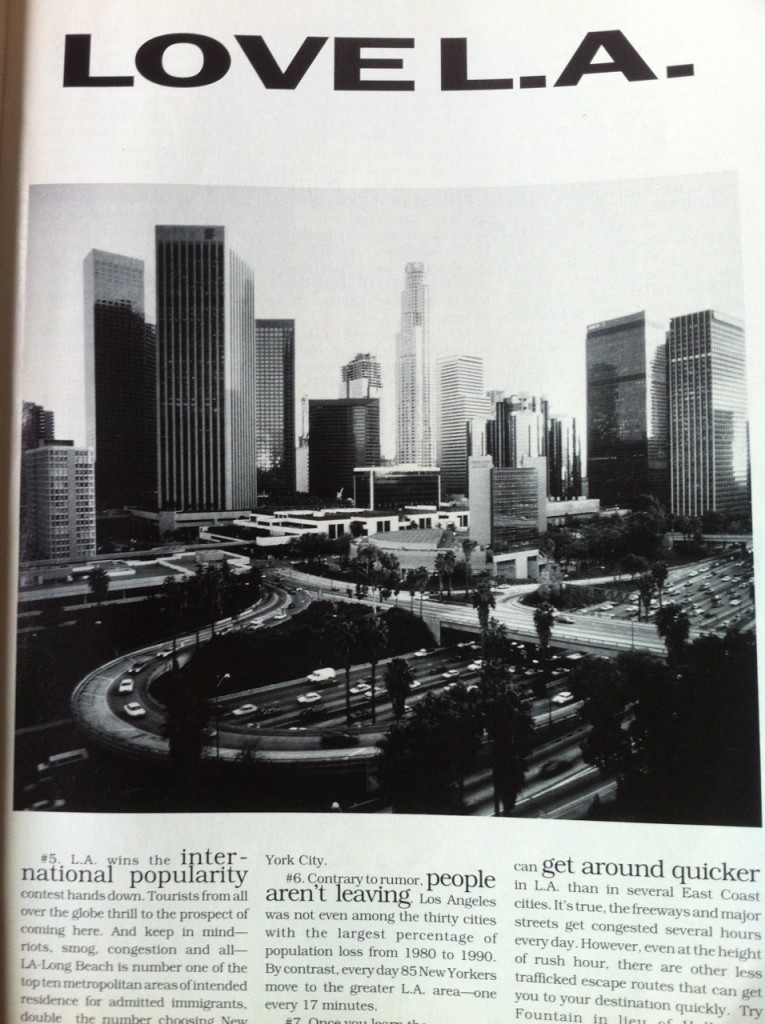On the Wilshire Walk I met Michael Lane and Jim Crotty, creators of Monk magazine, a journal of “travel with a twist” and subcultural phenomenon that ran between 1986 and 1997. During that whole time, Michael and Jim traveled America in an RV and put the magazine together using early desktop publishing software and every Kinko’s they came across. I can’t even imagine the logistical headaches that must have entailed, though now the project looks like a clear forerunner to what so many enthusiasts of 21st-century media do today: a combination of traveling, talking, writing, taking pictures, and publishing as you go — except Michael and Jim had to sell their own ads.
Though back then just a financial necessity, time has transformed those ads, like any that appear in magazines from an earlier time, into fascinating pieces of content in and of themselves. On one spread in their Los Angeles issue, the left page advertises Stereo MCs’ Connected (whose title track, incidentally, is one of my standard karaoke jams); the right, Björk’s Debut. For these and other reasons, the Monk archive constitutes an invaluable archive of 1990s American culture, although at the moment that archive exists in only in the form of hundreds of paper issues stacked on a shelf.
I caught a glimpse of it when Michael invited me over to Monk Space, which he conveniently set up in Koreatown a five-minute ride up Western from my apartment, though he did it a decade ago, when that part of the neighborhood had fewer coffee shops and barbecue places and more homeless encampments and crumbling buildings housing a dozen Central Americans to the room. They run a few different audiovisual production facilities there, from a sound studio for mixing and dialogue recording sessions (though the occasional rapper also makes use of it, always with posse in tow) to a stage occupied, when I saw it, by a History Channel shoot. Weddings, too, make frequent and lucrative use of Monk Space. (I gather that whatever you do, if the wedding industry takes interest, you’ve got it made. Just watch out for bridezillas.)
Michael and Jim have stories about rolling into Los Angeles together in 1992, by many measures the city’s nadir: “the evil urban empire in our collective national psyche,” they wrote in their Los Angeles issue, “the land of riots, smog, uncontrolled gangs, congestion, ethnic rivalry, poor urban planning, and of course, police brutality.” But they wrote that in a piece titled “33 Reasons Why We Love L.A.” where they see a city “on the rebound. And in time the anti-L.A. myth will again give way to its more optimistic and enduring counterpart.”
The value they saw in Los Angeles even then remains, to a great extent, the value it offers today: “At any time in this city there are dozens of radically different cultures and subcultures completely immersed in their own orbits. Rich to poor, Zulu to Kampuchean, Christian fundamentalist to Satanic cults, straight to gay.” “We have found more intellectually alive people here than in, say, New York, which prides itself on its intellectual superiority.” “L.A. is wacky. L.A. is frivolous. Yet L.A. knows how to really work hard. You can count on things being done right.” And best of all: “the Brits are drawn here.”
But things don’t all stay the same: the decentralization the Monks celebrate in not one but two of their 33 reasons to love the city has turned back inward (a highly desirable thing, to my mind), and I doubt many Angelenos would believe that “you can get around quicker in L.A. than in several East Coast cities” if you said so today. They’d have the heartiest laugh at reason number eight: “Parking is rarely, if ever, a problem.” But for increasingly many, especially relatively recent arrivals such as myself, Los Angeles has become a place where parking is rarely, if ever, a consideration. But as the city’s physical form develops, in some (especially non-car-oriented) aspects dramatically, I do hope it can hold on to the wacky, the frivolous, and the intellectually alive, all those cultures and subcultures, and of course, the Brits.



